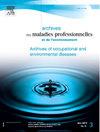Association entre le télétravail imposé par la Covid-19 et les cervicalgies : résultats à partir de la cohorte Constances
IF 0.3
4区 医学
Q4 PUBLIC, ENVIRONMENTAL & OCCUPATIONAL HEALTH
Archives Des Maladies Professionnelles Et De L Environnement
Pub Date : 2025-05-26
DOI:10.1016/j.admp.2025.102886
引用次数: 0
Abstract
Objectif
Étudier les associations entre les cervicalgies nouvellement déclarées depuis le début du premier confinement et le télétravail à domicile imposé par la Covid-19.
Méthodes
Les participants étaient des volontaires de la cohorte Constances, inclus entre 2012 et 2019 ayant participé au projet SAPRIS (Santé, perception, pratiques, relations et inégalités sociales en population générale pendant la crise Covid-19) mis en place au début du premier confinement imposé par la Covid-19. Les participants qui avaient déclaré des cervicalgies au cours des 12 mois précédant le questionnaire de suivi 2019 ont été exclus. Les données issues d’auto-questionnaires complétés en 2020 ont été analysées. Des régressions logistiques ont été effectuées pour étudier les associations entre les cervicalgies nouvellement déclarées depuis le début du premier confinement et le télétravail à domicile.
Résultats
L’échantillon d’étude comprenait 10 101 personnes (5357 hommes et 4744 femmes), 2,1 % des hommes et 4,4 % des femmes ont signalé des cervicalgies depuis le début du confinement (p-valeur < 0,001). Chez les femmes, le fait d’être nouvellement en télétravail pendant le confinement et de l’avoir poursuivi après (référence : pas de télétravail) et un télétravail fréquent (> 50 % du temps de travail en télétravail, référence : pas de télétravail) pendant le confinement étaient associés aux cervicalgies. Aucune association n’était significative chez les hommes.
Conclusion
Outre le télétravail lui-même, la proportion du temps de travail en télétravail est un facteur important associé aux cervicalgies. La prévention doit prendre en compte non seulement l’environnement de travail mais aussi l’organisation du travail, en particulier la durée du télétravail.
Objective
To study the associations between incident neck pain and remote work imposed by the COVID-19 pandemic.
Methods
Participants were volunteers from the French Constances cohort, included between 2012 and 2019, and who took part in the nested SAPRIS survey (Santé, pratiques, relations et inégalités sociales en population générale pendant la crise Covid-19) since the beginning of the first lockdown due to the COVID-19. Participants who had reported neck pain during the preceding 12 months on the 2019 follow-up questionnaire were excluded. Data from self-questionnaires completed in 2020 were analyzed. Logistic regression analyses were run to test the associations between incident neck pain since the first lockdown and remote work, stratified by gender.
Results
The study sample comprised 10,101 people (5357 men and 4744 women), of which 2,1% of men and 4,4% of women reported neck pain since the first of the lockdown (P-value < 0.001). In women, new teleworking during and continued after the lockdown (reference: no teleworking) and frequent teleworking (more than 50% of the working time in teleworking at home, reference: 0%) during the lockdown were associated with neck pain. No associations were significant in men.
Conclusion
In addition to teleworking itself, the proportion of working time in teleworking at home is an important factor associated with neck pain. Prevention should take into account not only the work environment but also the work organization, particularly the duration of teleworking.
COVID -19远程办公与宫颈癌的关系:康斯坦斯队列的结果
研究自首次封锁开始以来新报告的宫颈疼痛与COVID -19实施的在家远程工作之间的联系。方法参与者是康斯坦斯队列的志愿者,包括2012年至2019年期间的志愿者,他们参与了SAPRIS (COVID -19危机期间一般人口的健康、认知、实践、关系和社会不平等)项目,该项目在COVID -19首次封锁开始时启动。在2019年随访问卷之前的12个月内报告宫颈疼痛的参与者被排除在外。对2020年完成的自我调查数据进行了分析。后勤方面的倒退是为了研究自第一次封锁开始以来新报告的宫颈癌与在家远程工作之间的联系。研究样本包括10101人(5357名男性和4744名女性),自封锁开始以来,2.1%的男性和4.4%的女性报告了宫颈疼痛(p值)。0.001)。对妇女来说,在封锁期间刚开始远程工作,之后又继续远程工作(参考:没有远程工作)和经常远程工作(“gt;在封锁期间,50%的远程工作时间(参考文献:没有远程工作)与宫颈痉挛有关。在男性中没有显著的关联。除了远程工作本身,远程工作时间的比例是与宫颈癌相关的一个重要因素。预防工作不仅必须考虑到工作环境,而且还必须考虑到工作的组织,特别是远程工作的时间。目的:研究颈痛事件与COVID-19大流行造成的远程工作之间的联系。方法参与者是来自法国康斯坦斯队列的志愿者,包括2012年至2019年,自COVID-19首次封锁开始以来,他们一直参与了SAPRIS (COVID-19危机期间一般人口的健康、实践、关系和社会不平等)调查。在2019年的跟踪调查中,在过去12个月内报告颈部疼痛的参与者被排除在外。分析了2020年完成的自我问卷数据。在过去的几个月里,我一直在寻找一种新的方法来解决我的问题。研究样本包括10101人(5357名男性和4744名女性),其中2.1%的男性和4.4%的女性报告自第一次封锁以来颈部疼痛(P值为“P”)。0.001%)。在女性中,在封锁期间和封锁后新的远程工作(参考文献:没有远程工作)和频繁的远程工作(超过50%的家庭远程工作时间,参考文献:0%)与颈部疼痛有关。在男性中没有明显的联想。结论:除了远程工作本身,在家远程工作的工作时间比例是与颈部疼痛相关的一个重要因素。预防不仅应考虑到工作环境,还应考虑到工作组织,特别是远程工作的持续时间。
本文章由计算机程序翻译,如有差异,请以英文原文为准。
求助全文
约1分钟内获得全文
求助全文
来源期刊

Archives Des Maladies Professionnelles Et De L Environnement
医学-公共卫生、环境卫生与职业卫生
CiteScore
0.40
自引率
50.00%
发文量
185
审稿时长
50 days
期刊介绍:
The Archives of Occupational and Environmental Diseases (Archives des maladies professionnelles et de l''environnement) publish scientific original articles in the form of memoirs, developments and general health reviews. The journal is a reliable source of information, which lets you gain additional knowledge or update your knowledge of basic or original issues.
The section Continuous professional development focuses on a major issue and gives you the tools to optimize your practice. The content is divided in 3 parts: Reading Test, Answer to the Reading Test and Scientific Press Review, which let you share the analysis, by the editorial board, of articles from major English-language journals.
The section Legal Environment discusses an environmental culture. The section Letter to the editor keeps you informed about the press review; the Legislation, with the latest regulations published in the Official Journal; and the agenda of the meetings and the Congress, the questions–answers, etc. The Archives of Occupational and Environmental Diseases include all the scientific communications of the French occupational health societies, of which they are the official journal.
 求助内容:
求助内容: 应助结果提醒方式:
应助结果提醒方式:


